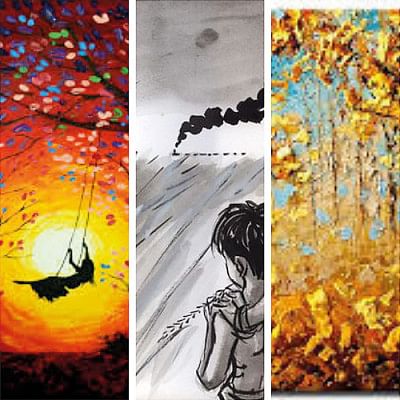In the Turmeric Fields: The World of Bibhutibhushan Bandyopadhyay

"Holud bonay bonay
Naakchhabiti hariye gechhe
Shukh neiko monay…"
(In the turmeric fields
I lost my nose-pin
Feeling so unhappy…)
Young Durga of Pother Panchali chanted the rhymes as she wandered amidst the wildernesses of Nischindipur. No, she did not make up the lyrics; they were taught to her by her elderly aunt Indir Thakrun. I myself was very young when I first came across the tale of Apu and Durga, but the words got imprinted in my mind and I used to recite them as I played in the overgrown shrubbery and empty plots of Banani in the late seventies. The glitzy high-rise buildings were still decades in the future, I was free to romp around with a stick in hand and imagine myself as Durga and my little brother as Apu. I did not know the exact meaning of these lines but the holud bon or the yellow forest/ turmeric fields beckoned to me like a magical sun-drenched domain where my imagination ran wild and I could get a break from the tedious routine of homework and school.
This article, however, is not only about the world of Apu and Durga, but the amazing and picturesque depiction of the rural Bengal in Bibhutibhushan Bandyopadhyay's work. Everybody familiar with Bengali literature knows about the Apu trilogy, the first two volumes of which were written by Bibhu Babu and the third, by his son Tarapada Bandyopadhyay. Bandyopadhyay's short novel Aranyak also gained fame because of its critique of urbanization and the destruction of natural habitats. Love for nature and rustic people of the rural north Bengal lies at the heart of this novella.
My admiration for Bibhu Babu's prose began with Pother Panchali, extended to Aranyak, and then expanded with his huge volume of short stories. I still remember sitting in a corner of our veranda, poring over the tales. Some of my first stories were "Kinnordol," featuring the gifted cousins with musical talent who died early, the magical and romantic story of a flutist in "Meghmallar," who committed an atrocious crime unknowingly against the goddess of music and wisdom and his atonement, the simple and ardent wishes of a poor boy in "Taalnobomi," to be invited to a better-off neighbor only to have his heart broken and the mysterious appearance of a girl when a visitor arrives at his ancestral house in "Paitrik Bhita.""Puin Macha" is one story that all readers of Bibhutibhushan remember: the adolescent girl who loved to eat puin shak, and was often harassed by her mother. But when she dies at her in-laws' house, the memory comes back to haunt her family members. The emotions explored in these short stories are simple and genuine; human follies are exposed, sometimes even made fun of, but most important of all, they are depicted in a background of a rural Bengal that is now almost gone. The pages are steeped with descriptions of the shal forests of the Northern districts, the hushed repose of an Arcadian expanse, steep mountain paths, lonely villagers, starlit nights and all that comes with such explorations. The author draws the portrayals with the compassion of a fellow human, and indeed the everyday sorrows that might seem insignificant to great writers concerned with national crisis, turn vivid and reach out to the readers.
I have often wondered why I am so much taken in with Bibhutibhushan Bandyopadhyay's work, what mystery is there in his writing that appeals to me more than any other Bengali fiction writer. One reason, of course, is that I grew up with his characters, but the more important reason is that in his description of nature and stories, I discover the quintessential spirit of the nineteenth and early twentieth-century Bengal. There are critics who have criticized Bibhu babu's romanticizing of poverty as opposed to Manik Bandyopadhyay's realistic representation of rural Bengal, or Tarashankar's political standing in locating the same rural atmosphere through a critical lens. Bubhutibhuhan Bandyopadhyay's art is very different from both the other Bandyopadhyays. I would say that he doesn't idealize or romanticize poverty, but softens its harshness. Indeed, his brush strokes are softer with colorful hues, whereas Manik Mandyopadhyay uses crude charcoal to bring out the coarser aspects of life. Yet, in some significant ways, Bibhu babu's portrayal of nature is unparalleled, where light and darkness cause miracles, like a chiaroscuro painting in words, where one can visualize the red dirt roads curving around the meadows, hear songs of unseen birds in the woods, see lonely travelers with meager belongings, and the rich abundance of natural beauty.
I have often felt that Bibhutibhushan Bandyopadhyay's place in Bengali literature is parallel to that of Jibanananda Das. One of them brings in the beauty of rural Bengal in prose and the other in poetry. Jibanananda Das ventures to walk thousands of miles through the historical spots of ancient India while Bibhutibhushan ambles along the untrodden greenery of north-western Bengal, identifying various birds and wild creatures in his sojourn. Theirs are the tales of Wordsworthian rustics that never get to enjoy the commodities of modern life. What can we as readers expect to gain from that life? We often speak of rural simplicity. Or, perhaps it is our version of Arcadia? Many would perhaps not care to look back at the past any more. The urbanization and materialistic aspects of life hinder us from looking back except perhaps in our dreams and imagination. But sometimes, all of us need to think of the days past, of our cultural history, of the shambles we stand on. We need to connect ourselves with our forefathers and foremothers, with our roots that go deeper than all the hullabaloos we immerse ourselves everyday.
So, I come back to the beginning of my essay. What and where is this holud bon? Is it merely a reference to the golden paddy fields? Or, is it some actual turmeric field or forest? Or, perhaps, it is neither. When Durga ran along the wilderness with her brother, she was about twelve years old— a mere child from our perspective. But during those days, that was a marriageable age, and Durga might have very well been dreaming of a happy conjugal future. She does blush and shy away at the prospect of union with a young man visiting the neighbourhood. The holud bon could very well be a reference to the marriage ritual of gaye holud. Then again, the loss of one's nose-pin signifies ill-omen, and hence along with hope there is also a tinge of anxiety: what if things do not go smoothly? Even if Durga had lived instead of dying young, how much happiness could have her parents bought in a marriage that depended on dowry and the social status of her father? The times may have changed and the songs and places may differ, but the tension and dreams still abound. The lives of the rustic people of Bengal still go about in the very same manner.
Sohana Manzoor is Associate Professor, Department of English & Humanities, ULAB. Currently, she is also the Editor of Star Literature and Reviews Pages.

 For all latest news, follow The Daily Star's Google News channel.
For all latest news, follow The Daily Star's Google News channel. 



Comments